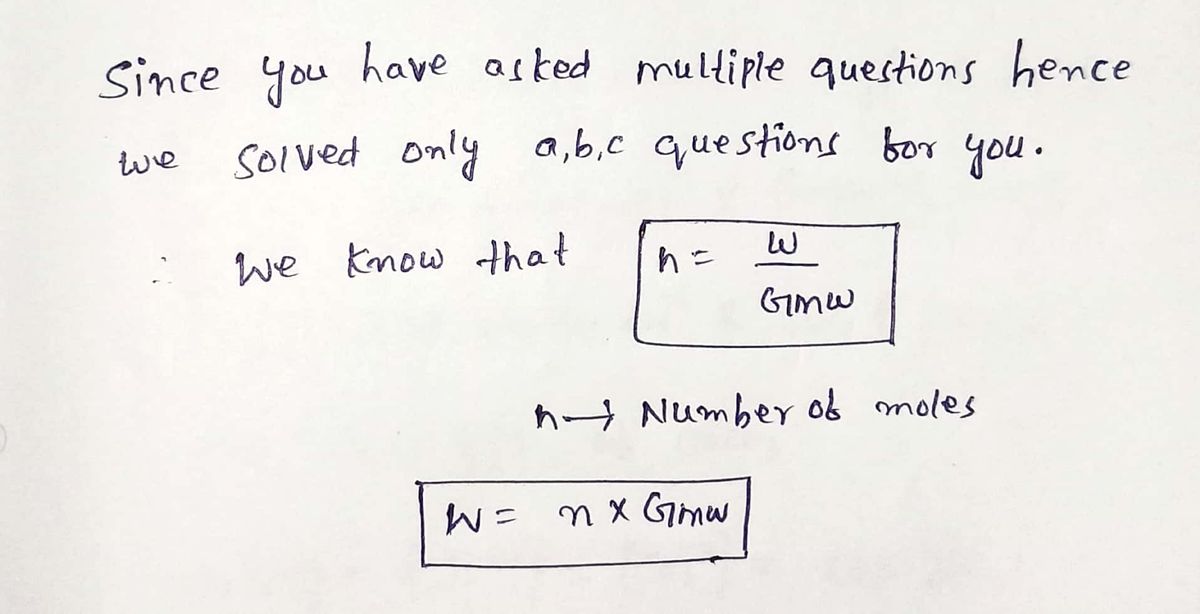2. Calculate the constituents below in units of mass per volume. Give your answers in the most appropriate units (for example, g/L, mg/L, or µg/L depending upon the magnitude of your answer). See Table A-9 in the appendix of your book for necessary information. a. 2 x 10'M PbS (as long as it stays solid, can keep lead out of water) b. 0.830 M CaCO; (important in the carbonate system and ocean acidification) c. 0.070 N Mg(OH)2 (formed during softening in water treatment)
2. Calculate the constituents below in units of mass per volume. Give your answers in the most appropriate units (for example, g/L, mg/L, or µg/L depending upon the magnitude of your answer). See Table A-9 in the appendix of your book for necessary information. a. 2 x 10'M PbS (as long as it stays solid, can keep lead out of water) b. 0.830 M CaCO; (important in the carbonate system and ocean acidification) c. 0.070 N Mg(OH)2 (formed during softening in water treatment)
Chemistry
10th Edition
ISBN:9781305957404
Author:Steven S. Zumdahl, Susan A. Zumdahl, Donald J. DeCoste
Publisher:Steven S. Zumdahl, Susan A. Zumdahl, Donald J. DeCoste
Chapter1: Chemical Foundations
Section: Chapter Questions
Problem 1RQ: Define and explain the differences between the following terms. a. law and theory b. theory and...
Related questions
Question

Transcribed Image Text:2. Calculate the constituents below in units of mass per volume. Give your answers in the most
appropriate units (for example, g/L, mg/L, or µg/L depending upon the magnitude of your
answer). See Table A-9 in the appendix of your book for necessary information.
a. 2 x 10' M PbS (as long as it stays solid, can keep lead out of water)
b. 0.830 M CACO; (important in the carbonate system and ocean acidification)
c. 0.070 N Mg(OH)2 (formed during softening in water treatment)
d. 1.50 N HCI (used for neutralizing solutions with high pH)

Transcribed Image Text:TABLE A-9
Typical solubility product constants
Equilibrium equation
Kyp at 25°C
AgCl = Ag* + Cl¯
Al(OH)3 = Al³* + 30H¯
AIPO4 2 Al³+ + PO-
BaSO4 2 Ba?+ + so?
Cd(OH), = Cd²+ + 20H¯
CdS = Cd²+ + s²-
-10
1.76 × 10¬
–33
1.26 X 10
9.84 × 10
1.05 × 10
-21
-10
5.33 X 10-15
-29
1.40 × 10
CdCO3 = Ca²+ + CO?
CaCO3 = Ca²+ + CO?-
CaF2 = Ca²+ + 2F
Ca(OH)2 = Ca²+ + 20H¯
6.20 × 10-12
4.95 × 10-9
3.45 X 10¬11
7.88 × 10-6
2.02 X 10
Ca3(PO4)2 = 3Ca²+ + 2PO-
CASO4 = Ca²+ + SO?
Cr(OH); = Cr** + 30H¯
Cu(OH)2 = Cu²+ + 20H¯
CuS = Cu?+ + s²-
-33
4.93 × 10-5
6.0 X 10-31
-19
2.0 X 10
1.0 × 10-36
Fe(OH)3 = Fe* + 30H¯
– 39
2.67 X 10
1.3 X 10
FEPO4 2 Fe* + PO
FECO, = Fe2+ + CO?-
Fe(OH) = Fe²+ + 20H¯
Fes = Fe?+ + S²-
-22
3.13 × 10¬11
-17
4.79 X 10
1.57 × 10-19
1.48 X 10
P6CO3 = Pb²+ + CO?-
Pb(OH)2 = Pb²+ + 20H¯
PbS = Pb2+ + s²-
Mg(OH), = Mg²+ + 20H¯
MGCO3 = Mg* + CO?
MNCO3 = Mn²+ + CO}-
Mn(OH)2 2 Mn²* + 20H
Ni²+ + CO
Ni(OH)2 = Ni²+ + 20H¯
Nis = Ni?+ + S²-
SrCO3 2 Sr* + CO
Zn(OH), = Zn²+ + 20H
+ s?-
-13
-20
1.40 X 10
8.81 × 10'
5.66 X 10
1.15 × 10
-29
-12
-5
11
2.23 × 10¬
-13
2.04 X 10
1.45 × 10¬7
NİCO3
5.54 X 10¬16
1.08 X 10
-21
-10
5.60 X 10
7.68 × 10'
2.91 × 10
-17
ZnS 2 Zn
2+
-25
(Sources: Linde, 2000; Sawyer, McCarty, and Parkin, 2003; Weast, 1983.)
Expert Solution
Step 1

Trending now
This is a popular solution!
Step by step
Solved in 3 steps with 3 images

Knowledge Booster
Learn more about
Need a deep-dive on the concept behind this application? Look no further. Learn more about this topic, chemistry and related others by exploring similar questions and additional content below.Recommended textbooks for you

Chemistry
Chemistry
ISBN:
9781305957404
Author:
Steven S. Zumdahl, Susan A. Zumdahl, Donald J. DeCoste
Publisher:
Cengage Learning

Chemistry
Chemistry
ISBN:
9781259911156
Author:
Raymond Chang Dr., Jason Overby Professor
Publisher:
McGraw-Hill Education

Principles of Instrumental Analysis
Chemistry
ISBN:
9781305577213
Author:
Douglas A. Skoog, F. James Holler, Stanley R. Crouch
Publisher:
Cengage Learning

Chemistry
Chemistry
ISBN:
9781305957404
Author:
Steven S. Zumdahl, Susan A. Zumdahl, Donald J. DeCoste
Publisher:
Cengage Learning

Chemistry
Chemistry
ISBN:
9781259911156
Author:
Raymond Chang Dr., Jason Overby Professor
Publisher:
McGraw-Hill Education

Principles of Instrumental Analysis
Chemistry
ISBN:
9781305577213
Author:
Douglas A. Skoog, F. James Holler, Stanley R. Crouch
Publisher:
Cengage Learning

Organic Chemistry
Chemistry
ISBN:
9780078021558
Author:
Janice Gorzynski Smith Dr.
Publisher:
McGraw-Hill Education

Chemistry: Principles and Reactions
Chemistry
ISBN:
9781305079373
Author:
William L. Masterton, Cecile N. Hurley
Publisher:
Cengage Learning

Elementary Principles of Chemical Processes, Bind…
Chemistry
ISBN:
9781118431221
Author:
Richard M. Felder, Ronald W. Rousseau, Lisa G. Bullard
Publisher:
WILEY